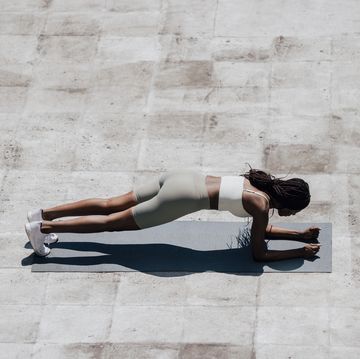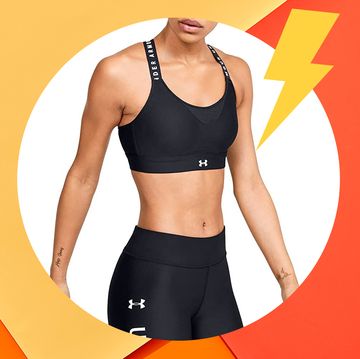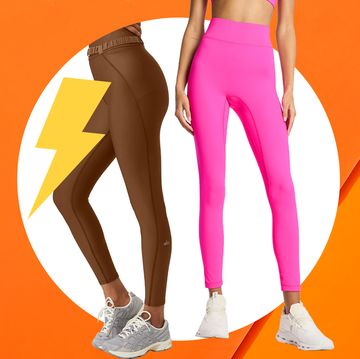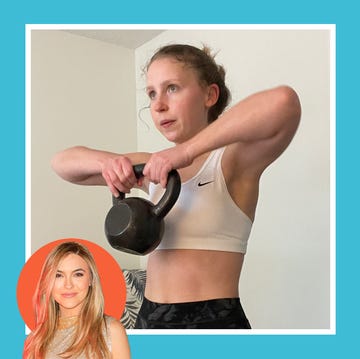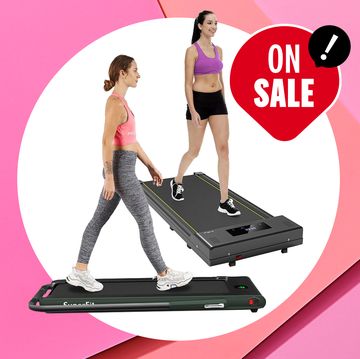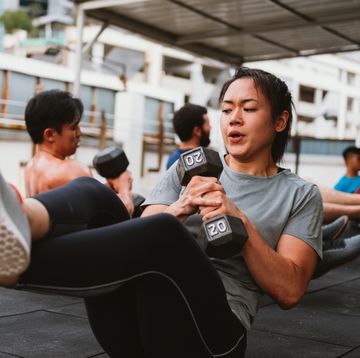One workout guaranteed to get your heart and good vibes pumping is cardio. After all, cardiovascular exercise, or cardio for short, is moving your body with the purpose of increasing your heart rate, Megan Clare, CPT, says. “Not only will you break a sweat and get your blood flowing, but you will also feel all the good feels from it," she adds.
That doesn't mean you need to hop on the treadmill. If you don't love running, don’t sweat it (see what I did there?). There are tons of different effective cardio exercises. Beyond the elliptical, stationary bike, or treadmill, there’s also high-intensity interval training (HIIT), hiking, swimming, and rowing. Plus, some strength training moves will get you out of breath, serving as a bonus cardio exercise.
Meet the experts: Megan Clare, CPT, is a Certified HIIT Cardio & Functional Strength Trainer at Mind Body Project. Laura Girard, CPT, is an online fitness and certified nutrition coach and founder of The Energy Academy.
More From Women's Health

Cardio exercises boost a lot more than your heart rate, though. Cardio moves help you maintain a healthy weight and sleep better, improve cardiorespiratory fitness, reduce risk of cardiovascular diseases and high blood sugar, and even extend life expectancy, an NIH study found.
Upping the intensity in your cardio exercises is clutch. You can cut your cardio time in half (from 150 to 75 minutes per week, per the U.S. Department of Health's physical activity guidelines) by opting for HIIT or circuit training. Why? The higher the intensity of your sweat sesh, the more energy and oxygen you use and the greater after-burn effect (otherwise known as EPOC) you experience. That means you'll continue to burn calories at a higher rate after your workout as your body returns back to its regularly scheduled program.
Enough talk, it's time to sweat. Use this list of the best cardio exercises from trainers to create efficient, fresh workouts that offer full-body benefits. Oh, and you can do them practically anywhere, too.
Time: 20 minutes | Equipment: mat, kettlebell, dumbbells, jump rope (optional) | Good for: total body, cardio
Instructions: Choose six to eight exercises below. Complete the indicated number of reps for each move, then immediately continue onto the next. After you've finished all of your movements, rest for 30 seconds to 1 minute. Then, repeat twice more for a total of three rounds.
1. Squat Jump
Why it rocks: "When we practice generating power, it’s great to keep it simple so we can focus on bringing 100 percent effort," says Laura Girard, NASM-CPT, an online fitness and certified nutrition coach and founder of The Energy Academy. Plus, it works the quads, glutes, calves, and core.
How to:
- Start in a squat (feet under shoulders, toes facing forward, thighs parallel to floor) with torso upright and hands clasped in front of chest.
- Press through feet to straighten legs and jump up off the floor while swinging straight arms behind body.
- Land back in a squat position. That's 1 rep. Perform 10 reps.
Modify it: Instead of fully jumping off the floor, do a calf raise on the balls of the feet or squeeze your glutes to stand up with power, Girard says. Just remember to keep your heels down at the bottom of the squat.
2. Burpee
Why it rocks: Don't skip this one, it's a trainer go-to for a reason. This move works muscles in your entire bod, and it requires zero equipment.
How to:
- Start standing, with hands at sides.
- Hop up into the air.
- As you land, squat down and press your hands into the ground.
- Jump your legs back behind you to form a plank and simultaneously lower chest to the ground.
- As you lift chest up, jump feet back to land directly under the body.
- Hop up to standing. That's 1 rep. Perform up to 10 reps.
3. Split Lunge Rainbow Slam
Why it rocks: It's great for working the shoulders and obliques simultaneously, as well as the lower body.
How to:
- Start in a lunge holding a medicine ball in front of left hip.
- Brace core and hold isometric lunge as as you swing medicine ball in arc with force.
- Bounce ball off the ground outside left foot.
- Pick it up and return to start. That's 1 rep. Perform as many reps as possible for 45 to 60 seconds, then switch sides.
Modify it: Perform the movement without a ball, or with a pillow instead.
4. Speed Skater
Why it rocks: "We don’t get enough lateral (side-to-side) motion in every day life—it’s great for keeping our hips and knees strong and is supported by targeting muscles like the glute medius," Girard says. Plus, it works the quads, glutes, and calves, and it's used by athletes that change directions quickly in their sports, i.e., soccer and tennis.
How to:
- Start in a standing position with feet under hips.
- Jump out to the right side with your right foot, allowing the left foot to trail behind into a small curtsy tap as the arms pump across the body (like a speed skater).
- Repeat to the other side. That's 1 rep. Perform until you get to 20 reps.
Modify it: Take out the bound for a low-impact speed skater or feel free to perform the move in a chair.
5. Mountain Climbers
Why it rocks: Not only do mountain climbers work your shoulders and core, but they also engage your hip flexors, Girard says. They're especially helpful for runners and dancers.
How to:
- Start in plank position, feet hip-distance apart, hands shoulder-width apart.
- Drive right knee into chest, then bring to start.
- Repeat on left side.
- Continue switching sides. Perform as many reps as possible in 45 seconds.
Modify it: Slow down to work your core more. To level up, do them on an incline, or add a band around the feet to strengthen your hip flexors.
6. High Knees
Why it rocks: Girard likes targeted hip flexor work and jumping moves that help create more power. "Keep these in a short burst and focus on driving the knees as if you were doing a standing mountain climber," she adds. This move works the quads, calves, hip flexors, and core.
How to:
- Start in a standing position on mat.
- Bend arms at 90 degree angles, elbows close to sides, and hands at hip height in front of body.
- Bend right leg and lift right knee up to tap palm.
- Return right knee to floor.
- Quickly repeat on left side. That's 1 rep. Continue alternating sides, increasing speed for an added challenge. Perform 20 reps.
Modify it: Keep one foot on the ground and drive up the other knee towards your chest, then switch sides, Girard recommends. Or, just focus on the foot landing on the floor, switching out the prance.
7. Kettlebell Swing
Why it rocks: Working the glutes and core, the kettlebell swing is wonderful at generating power in your hinge, she explains—it's low impact, but high reward! "A strong kettlebell swing will translate to a stronger squat, plank, and jump, and also help you learn how to decelerate a moving load," she continues.
How to:
- Start in a hinge (hips back, knees slightly bent, torso leaned forward at 45 degrees)
- Hold the handle of a kettlebell with both hands, arms extended straight toward floor and bell between knees on the floor.
- In one motion, squeeze glutes, straighten legs, lift torso, and thrust hips forward, while swinging the weight to chest height, keeping arms straight and core tight.
- Reverse the movement, bringing the kettlebell between thighs this time when you hinge. That's 1 rep. Perform 10 reps.
8. Pencil Jump
Why it rocks: It's a great warm-up move, especially if you have a hard time connecting your feet and ankles, Girard says. (Just make sure you don't lock out your knees.) The pencil jump works the core, calves, and feet.
How to:
- Start standing, feet shoulder-width apart.
- Keep arms by sides.
- Jump up and down by bouncing off the balls of the feet. Perform as many reps as possible in 45 seconds.
Pro tip: To level up this move, put your arms overhead for a little more of a core challenge.
9. Plank Get-Up
Why it rocks: They work the shoulders, chest, triceps, and core, and build coordination and confidence in the upper body, Girard says. Plus, they're always challenging! In terms of form, make sure the hands are planted under the shoulders so your neck doesn't become tense.
How to:
- Start in a low plank with forearms on the floor and parallel and elbows under shoulders.
- Pick up right forearm and press through palm to extend arm straight.
- Then, repeat with left to come into a high plank, keeping hips as level as possible.
- Reverse the movement to return to start. That's 1 rep. Perform 10 reps, alternating which arm you start with.
Pro tip: Perform the move from your knees if a full plank is too challenging. Level it up by adding a shoulder tap to work the core more.
10. Butt Kicks
Why it rocks: It's a great warm-up move, working the hamstrings, calves, and core, Girard says. "Think about dropping the tailbone towards the floor—a more neutral pelvis will help you get the most out of this move," she adds.
How to:
- Start standing and engage your core.
- Bring right heel behind you to touch your right glute.
- Bring right foot back down to ground.
- Repeat on the opposite side.
- Continue alternating sides, and speed it up for an added challenge. Perform as many reps as possible in 30 seconds.
11. Half Turkish Get-Up
Why it rocks: The half get-up is incredible at strengthening core and shoulder stability. However, the cardio benefits from it are more limited, Girard says.
How to:
- Start by lying on your back.
- Set up so your right leg and arm are straight on the floor and at a 45-degree angle from body.
- Bend your left leg, so your foot is flat on the floor, and extend your left arm up toward the ceiling (elbow locked out) holding a kettlebell.
- Keeping your eyes on the kettlebell, press into right arm, and sit up, coming onto right forearm.
- Then, press through right palm and left foot to lift hips into air, keeping right leg straight.
- Slowly reverse the movement to return to starting position. That's 1 rep. Perform 10 reps per side.
12. Tuck Jump
Why it rocks: A tuck jump has a lot of impact, "which is great for strong bones and joints, but also means these will be difficult to sustain to build up cardio endurance," Girard says. That means you will really rev up your heart rate.
How to:
- Start standing.
- Jump straight up, tucking knees to your chest.
- Land softly, and immediately spring up to repeat. Perform as many reps as possible for 20 seconds at maximum effort, followed by 10 seconds of rest.
13. Star Jump
Why it rocks: It trains your coordination and lateral movement, so feel free to modify it if you want, Girard says.
How to:
- Start with both feet firmly planted on the ground, with knees slightly bent.
- Jump as high as you can and stretch your arms out straight in either direction.
- Return to start. That's 1 rep. Perform 20 reps.
Modify it: Perform traditional jumping jacks.
14. Single-Arm Push Press
Why it rocks: The push press is super simple, but works your shoulders, quads, and core, Girard says.
How to:
- Start standing with feet just wider than hips.
- Hold a dumbbell (or kettlebell) in your right hand and bend your right arm with your elbow close to body so that the weight rests on shoulder. Place your left hand on your hip.
- Sink hips slightly into a quarter-squat.
- Quickly push through feet to extend legs, simultaneously pressing kettlebell straight up until right arm is completely extended overhead.
- With control, lower kettlebell back down. That's 1 rep. Perform 10 reps per side.
15. Bulgarian Split Squat
Why it rocks: While it won't get you the most out of breath, it will strengthen your quads and glutes, she adds.
How to:
- Start standing about two feet in front of an elevated surface (step, bench, chair, etc). Optional: Hold a weight in one or both hands.
- Extend left leg back and place left foot on step.
- Bend knees to lower body as far as you can (or until knee hovers right above the ground), keeping shoulders back and chest up.
- Pause, then press through right heel to return to start. That's 1 rep. Perform up to 10 reps on each side.
Pro tip: To add a variation, load one heavier weight either contralaterally (opposite side) or ipsilaterally (same side) to add core and stability training, Girard recommends. Consider adding a hop at the top instead, for more power.
16. Kettlebell Squat Clean
Why it rocks: It's great for building mental skills while working multiple major muscle groups.
How to:
- Start in a deep hinge position (hips back, knees bent, and torso leaned forward almost parallel to floor).
- Hold a kettlebell on the floor between your feet.
- Squeeze glutes and press hips forward to straighten legs and lift weight up keeping it close to shins.
- When bell reaches knees, bend elbows and pull it up to chest.
- Then, bend knees and sink hips back and down into a squat.
- Once thighs are about parallel with floor, press through feet to extend legs and return to standing position. That's 1 rep. Perform 10 reps.
17. Plank Jacks With Shoulder Taps
Why it rocks: This plank move has all the benefits of a jumping jack with extra upper body and core work, so it trains your shoulders and core.
How to:
- Start in a forearm plank position.
- Jump feet out past shoulders to a wide "V" shape, while simultaneously tapping left shoulder with right hand.
- Jump your feet back in again to the original plank position.
- Jump feet our to a wide "V" shape, while simultaneously tapping right shoulder with left hand. That's 1 rep. Perform 10 reps.
Modify it: Step your feet out side-to-side for less impact and more focus on the core.
18. Bear Crawl
Why it rocks: Bear crawls are "great for a coordination challenge, and also help build ankle mobility, especially moving backwards," Girard says. They work your shoulders, core, and quads.
How to:
- Start in bear plank, with shoulders over wrists and knees under hips and elevated a few inches off of mat.
- Step your left hand and right foot forward at the same time.
- Step your right hand and left foot.
- Keep back flat and hips stable.
- Take three steps forward, then three steps backward. That's 1 rep. Perform 10 reps.
19. Bear Plank Shoulder Tap
Why it rocks: This bear plank variation develops balance, stability, and major core strength, Girard says. It's especially beneficial for dancers or new parents who often carry their children at their hips.
How to:
- Start in bear plank, with shoulders over wrists and knees under hips and elevated a few inches off of mat.
- Keeping back flat and shoulders and hips stable, lift one hand up off mat.
- Bend arm at the elbow to tap your opposite shoulder.
- Replace hand to ground.
- Repeat on the opposite side. That's 1 rep. Perform 10 reps.
20. Jump Rope
Why it rocks: First and foremost, the impact is good for our bone and joint health. But also, "simple, repetitive moves like these are great for a cardio workout where you’re focusing on endurance," Girard adds.
How to:
- Start with feet together and arms by sides.
- Bend at elbows (but keep them close to body) to bring forearms wide and up to hip height.
- Begin making small circles with both forearms in a forward motion while simultaneously taking quick hops with feet. (If you're using a jump rope, the goal is to revolve the cord around body and clear it under feet with every hop.)
- One jump equals one rep. Perform 20 reps.
Pro tip: You can perform this move with or without an actual jump rope. The form is the same either way.
5 Cardio Exercise Benefits
If it feels like the benefits of cardio are endless, they kinda are, TBH. It's worth repeating the biggie boosts that come with these exercises, according to trainers.
- Lower risk of disease. Cardio workouts reduce your risk of obesity, heart disease, high blood pressure, type 2 diabetes, metabolic syndrome, strokes, and even lessens the chance of developing certain types of cancer. These moves are basically natural medicine.
- Stronger bones. Weight-bearing aerobic cardio exercises, such as walking, help lower your risk of osteoporosis.
- Improved mood. The activities increase blood flow which can improve your mood. “You will easily notice a difference in your energy levels over time after incorporating bits of cardio into your routine,” Clare says. A study published in the American College of Sports Medicine's Health and Fitness Journal found that even modest levels of exercise can contribute to the improvement of symptoms in people with depression.
- High calorie burn. Low-intensity cardio exercises, which keep your heart rate on the lower end, can help burn fat. High-intensity cardio workouts use carbohydrates in the body to fuel your movement, Clare explains.
- Better cognitive function. Aerobic exercise improves the brain's ability to reason, plan, and problem solve, according to a study by Columbia University"s Irving Medical Center.
Pro tip: “If anything feels wrong, stop right away," says Clare. "Pushing past discomfort is fine, but pushing past pain is not.” A five to 15-minute warm-up helps prep your bod to work and avoid injury.
Addison Aloian (she/her) is an editorial assistant at Women’s Health. When she’s not writing about all things pop culture, health, beauty, and fashion, she loves hitting leg day at the gym, shopping at Trader Joe’s, and watching whichever hockey game is on TV. Her work has also appeared in Allure, StyleCaster, L’Officiel USA, V Magazine, and Modern Luxury Media.





















